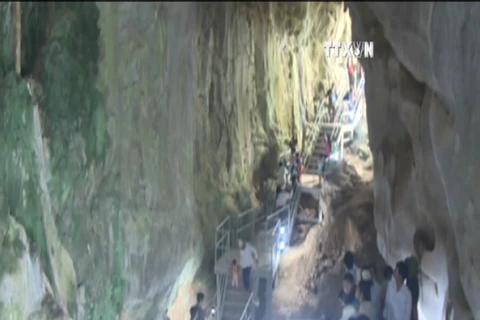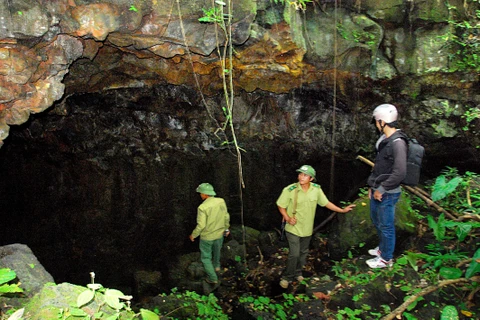Thanh Hoa (VNA) - A cave in the central province of Thanh Hoa has just been recognised as a Special National Archaeological Site by the Ministry of Culture, Sports and Tourism for its historic values.
A dossier on the cave is being compiled by Vietnamese experts to seek the UN cultural agency UNESCO’s recognition as a World Culture Heritage Site.
Discovered in 1974, Con Moong Cave has been excavated many times and is determined to be the first site ever in the country containing traces of the continuous living process of ancient humans from the Paleolithic period to the Neolithic period.
This is the fourth site in the province to be recognised as a National Relic Site, following Lam Kinh Historical Site, Ba Trieu Temple and Ho Citadel. The last has been recognised as a World Heritage site by UNESCO.
Con Moong (in ethnic Mường language means “animal”) Cave located in Thanh Trung village, Thanh Yen commune, Thach Thanh district, is at the ultimate height of 147m above sea level.
The cave is on a karst mountain, which belongs to the Dong Giao geological layer dating back to 240 million years ago.
The cave measures some 40m in length, with two gates on both ends. Inside the cave, the ceiling at some places is 10m high.
Since its discovery in 1974, the cave has been excavated four times. The first excavation in 1974 explored a total area of 24sq.m. The findings showed the continuous development of stone working tools of the Stone Ages in Vietnam.
In 2008-09, the cave was excavated the second time, while the next excavations were organised in 2010-13 and 2014.
Various other caves have also been discovered near Con Moong, including Lai Cave, Chun Cave, Bo Giao Cave, Diem Cave and Moc Long Cave.
Bui Thi Tuyet, an official from the Thanh Hoa Culture, Sports and Tourism Department, said following the findings by archaeologists at Con Moong Cave, this site is determined to be very valuable as it represents many ancient civilisations and shows the continuous presence of early humans during the historical periods.
Con Moong Cave has a soil structure that is 9.5m thick on average with 10 different layers.
From the first to the sixth layer (1-6m depth), scientists found many working tools, animal bones and snail shells. From the seventh to tenth layer, they found no animal traces but many working tools made of quartz, mostly at a depth of 8.5-9.5m.
Scientists also found that the earliest traces at the cave dated back to 40,000-60,000 years ago.
At Diem Cave, Russia and Vietnamese experts researched the soil, which is 1.95m thick, representing three layers of civilisations dated back to 11,240 years ago.
The cave was determined to be a residential area with tombs from various periods. Nearly 2,000 objects were found, including several stone working tools, bones and ceramic broken pieces, and three tombs.
At Mang Chieng Cave, located 4km from Con Moong Cave, archaeologists found layers representing three cultures at a depth of 1.2m. Ten tombs were found at the site, together with stone tools, bones and traces of bonfires. Bones of the corpses were broken and burnt before being buried.
“With such valuable excavation results, Con Moong Cave is among the very rare archaeological sites with thick and intact soil layers in Vietnam and Southeast Asia,” Pham Duy Phuong, director of the Thanh Hoa culture department, said.
“Objects found at the site are concrete evidence of the traditions of those residing in caves, their habit of making and using stone tools and the changes in techniques of making stone tools,” he said.
Pham Dang Quyen, vice chairman of the Thanh Hoa People’s Committee, said the authorities would draft a master plan to preserve and bring into full play the relic site.
“We will have a long-term plan to upgrade the roads leading to the site,” he said.
“We will also coordinate with the neighbouring provinces of Ninh Binh and Hoa Binh, and the Management Board of the Cuc Phuong National Park as the cave is located in Thanh Hoa province, although it belongs to the buffer zone of the Cuc Phuong National Park.
"Raising awareness among locals in preserving the site is also on our must-do list,” he added.-VNA
VNA























